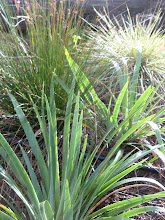
With a recommendation from Bob Zynbach and help from mmw, I've managed to find and read a disseration by Frank Lake, who wrote it for Oregon State University, and who is Karok. You can find the dissertation here. It's a very long document and I admit that I scanned over parts (especially the methods section), but I found several ideas and details making it worth the read.
About fire:
The starting of fires was considered a spiritual act capable of
serious consequences. Prayer formulas and other beliefs were associated with
burning. Once lit, fires were often spoken to as to how they should behave
and conduct themselves to achieve desired resource objectives of the igniter (p.
99).
A picture of what much of northern California and Southern Oregon looked like:
Patches and fields were located along trails that typically ran adjacent to rivers
and streams, the coast, and along ridgelines, directly connecting communities, peaks,
campgrounds, waterfalls, springs, and other favored subsistence and ceremonial
locations. Fires were also used to clear and maintain trails; rejuvenate berry patches,
wild pea fields, root and bulb fields, and orchards; for hunting; for weed control; and
to cure large fields of tarweed (Madia elegans Lindley) and grass seeds ("Indian
oats"). Daily and seasonal trail clearing activities, combined with seasonal and
occasional brush clearing, hunting, seed curing, and sprout-inducing burns were nearly year-around activities.
There is an interesting series of photographs in the paper showing that many
meadows traditionally maintained by fire have been lost. One example is at Patrick's Point (between Trinidad and Big Lagoon). When Europeans took over the area, they kept the meadows open with fire and with their cattle. When it was made into a State Park and the ranchers were removed, the spruce and shrubs began moving in. Today I know that there is at least one meadow area that the state burns occasionally to encourage the native prairie
plants.
meadows traditionally maintained by fire have been lost. One example is at Patrick's Point (between Trinidad and Big Lagoon). When Europeans took over the area, they kept the meadows open with fire and with their cattle. When it was made into a State Park and the ranchers were removed, the spruce and shrubs began moving in. Today I know that there is at least one meadow area that the state burns occasionally to encourage the native prairie
plants.
Indians used fire to clear brush and debris from riparian areas and marshes to
stimulate new grass, plant growth, and shrub and tree sprouts. Target
species were cottonwoods (Populus balsamifera spp. trichocarpa Torrey &
A. Gray), willows (Salix spp.), tules (Scirpus acutus Bigelow var. occidentalis
(S.Watson) Beetle), cattails (Typha latifolia L.), sedges (Carex spp.), and
grasses.
At work, I’ve been harvesting bareroot Scirpus microcarpus and water parsley plants. There is quite a bit of grass thatch below, making them difficult to pull up. I use a garden fork and my hands to pull the thatch away from the base of the plants, then use the fork lift the plants. Burning the thatch would save a great deal of time. If it were my nursery and my patches, I might do some experimenting.
I liked hearing about their trails.
Trails were about two feet wide, worn into bare mineral soil, and served as fire
lines in many cases for low intensity surface fires.
There are also many interviews with elder men and women from local tribes. I'm still reading through some of them. But I really should have taken better notes, I know I'm leaving out some important things.
P.S. I'm currently reading Tending the Wild by Kat Anderson.

2 comments:
Gardener:
I think your plan of getting a Masters degree is an excellent idea.
Your interest in oaks also has a good application in the redwood country you seem to prefer.
Kat Anderson is close to publishing her book on oaks, and I believe she may still teach at UC Davis.
Very nice mushroom pics, and great bottle cap story and illustration.
Keep up the good work!
Bob Zybach
Bob, I intended to ask whether or not Kat Anderson was still at UC Davis when I was at Davis, but it slipped my mind. It's good to hear she's publishing a book on oaks. It's strange how things seem to be coming together. You've certainly been helpful. Thanks for the encouragement.
Post a Comment